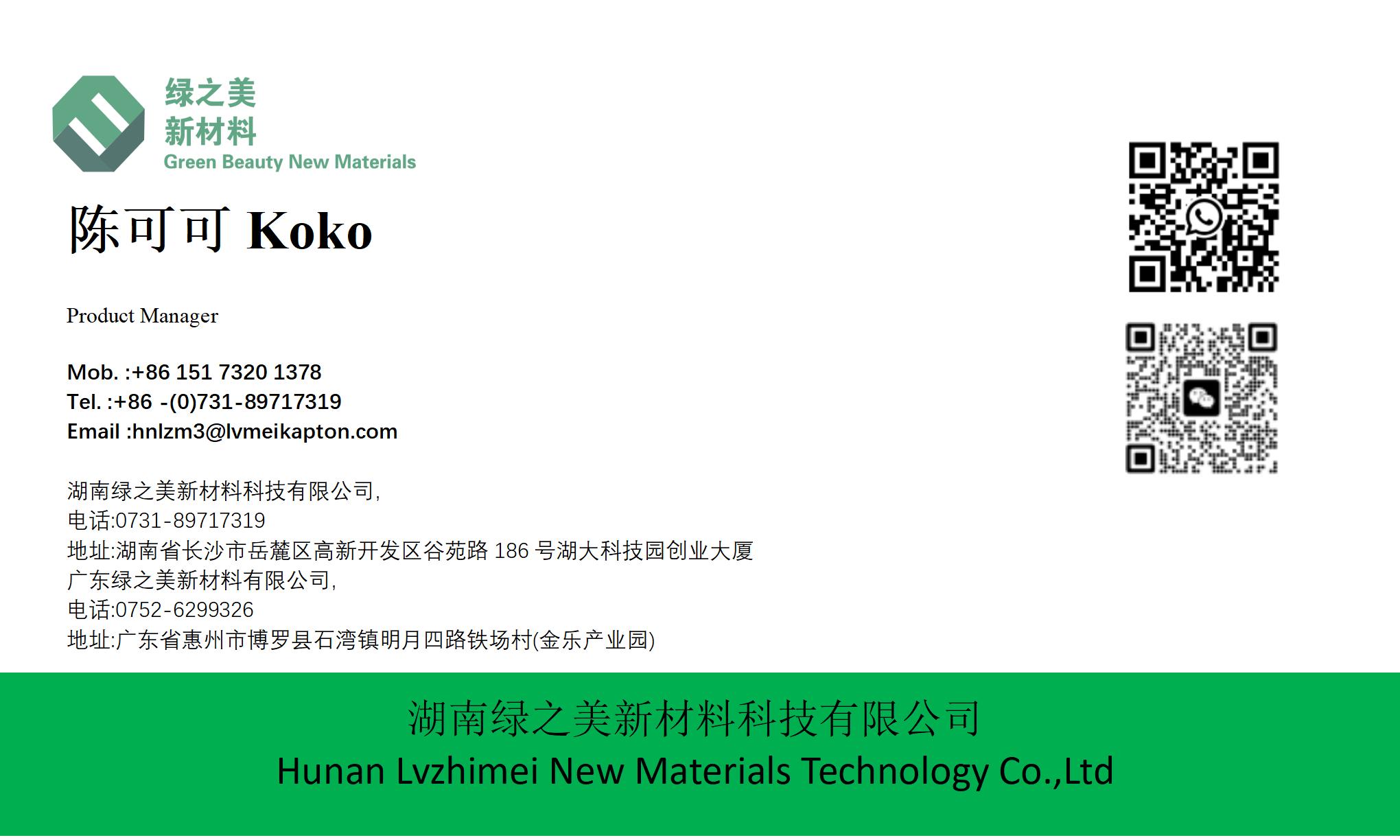hnlzm@lvmeikapton.com
+86 13787123465


Hunan Lvzhimei New Material Technology Co., Ltd.


NameDescriptionContent
When to Replace Traditional Tapes with Lvmeikapton Insulating Electrical Tape? |https://www.lvmeikapton.com/
Source:
|
Author:Koko Chan
|
Published time: 2025-07-16
|
9 Views
|
Share:
A comparison study outlining scenarios where Lvmeikapton tape outperforms PVC, vinyl, and other traditional electrical tapes.

1. Introduction1.1 Limitations of Traditional Tapes
Traditional insulating tapes such as PVC and PE, widely used in electrical insulation applications, have increasingly exposed their drawbacks with technological advancements.
PVC tape, despite its low cost and convenience, exhibits poor heat resistance. It begins to soften and deform when exposed to temperatures above 80°C, losing its insulating properties and posing a high risk of electrical failures. Moreover, it ages rapidly, becoming hard and brittle due to oxidation and UV exposure over time, resulting in significantly decreased adhesion and inadequate insulation protection.
PE tape also faces similar challenges. Its temperature resistance is limited (-40°C to 70°C), causing insulating performance degradation beyond this range. Additionally, its poor aging resistance makes it susceptible to cracking and degradation in outdoor or harsh environments, failing to meet high insulation requirements in scenarios like high-voltage cable protection, posing significant safety hazards.
2. Advantages of Lvmeikapton Tape2.1 Long-term Adhesion
Lvmeikapton tape excels in long-term adhesion. In electrical insulation scenarios, tapes must maintain firm adhesion to insulated objects for prolonged periods to ensure consistent performance. Lvmeikapton tape can retain 95% of its adhesion after five years, a critical advantage in long-term electrical systems.
Compared to traditional tapes that degrade and lose adhesion over time, Lvmeikapton tape, featuring high-quality polyimide film and silicone pressure-sensitive adhesive, maintains stable adhesion in high/low temperatures, humidity, and other complex environments. This prevents detachment or loosening, ensuring reliable insulation and reducing the risk of electrical failures caused by tape issues.
2.2 Wide Temperature Range
Lvmeikapton tape offers a remarkable temperature range of -60°C to 300°C, setting it apart in diverse insulation applications. In cold regions, traditional tapes harden and lose flexibility at low temperatures, compromising insulation. Lvmeikapton tape remains effective, ensuring outdoor electrical equipment functions normally.
In high-temperature environments like transformers and motors, traditional tapes soften, age, or melt, leading to insulation failure. Lvmeikapton tape, with its polyimide base, withstands 300°C without degradation, maintaining stable insulation and mechanical strength. This adaptability to extreme temperatures ensures reliable protection across various environments.
3. Replacement Application Scenarios3.1 Transformer Insulation
Transformers, crucial in power systems, demand high-temperature-resistant insulation. Traditional tapes soften and age rapidly in oil-immersed transformers, increasing failure risks.
Lvmeikapton tape’s wide temperature range (-60°C to 300°C) and superior insulation properties prevent thermal degradation. It effectively isolates coils and cores, reducing short-circuit risks and extending transformer lifespan. Its stability enhances power system reliability and safety, minimizing downtime and maintenance costs.
3.2 Underground Cable Insulation
Underground cables face continuous moisture and corrosive soil, necessitating waterproof and anti-corrosion protection. Traditional tapes absorb water, swell, and degrade, compromising cable insulation.
Lvmeikapton tape’s exceptional waterproofing and corrosion resistance block moisture infiltration and chemical attacks. Its stable performance in harsh environments prolongs cable lifespan, reduces maintenance costs, and ensures uninterrupted power transmission, crucial for urban infrastructure stability.
3.3 High-Voltage Switchgear
High-voltage switchgear controls power circuits under high voltage/current, demanding superior insulation. Traditional tapes fail under such stress, causing equipment breakdowns.
Lvmeikapton tape’s high voltage resistance, thermal stability, and durability improve switchgear insulation, lowering failure rates. Data shows its application significantly reduces breakdowns, ensuring power system stability and avoiding costly outages, essential for reliable electricity supply.
4. Investment Return Analysis4.1 Cost Comparison
Lvmeikapton tape’s initial cost is higher than traditional tapes due to premium materials (polyimide film) and complex manufacturing. It may be 3-5 times more expensive than PVC tape. However, traditional tapes require frequent replacements in harsh environments, driving up long-term maintenance costs.
Lvmeikapton tape’s longevity and stability reduce replacement frequency, offsetting initial investment. For critical systems, its total cost of ownership proves more economical over time.
4.2 Economic Benefits
Upgrading to Lvmeikapton tape enhances safety and reliability, saving costs from outages and equipment replacements. For example, preventing transformer failures avoids massive power losses and repair expenses. Its extended equipment lifespan and improved energy efficiency (e.g., reducing transmission losses in switchgear) further generate long-term savings, outweighing upfront costs.
5. Test Data Proofs5.1 Dielectric Strength
Dielectric strength measures a material’s resistance to electric fields. Lvmeikapton tape surpasses traditional tapes, with a dielectric strength over 20 kV vs. ~5 kV for PVC tape. In transformers with high inter-coil voltages, Lvmeikapton tape prevents breakdowns, ensuring safe operation.
5.2 Breakdown Voltage
Lvmeikapton tape’s breakdown voltage is significantly higher than traditional tapes, crucial in high-voltage switchgear. Its superior performance reduces the risk of catastrophic failures under extreme voltages, improving system safety.
5.3 Insulation Resistance
In humid environments, traditional tapes’ insulation resistance drops rapidly, increasing leakage current risks. Lvmeikapton tape maintains high resistance even in moisture, preventing electrical leaks and ensuring stable performance in underground cables and other wet conditions.
6. Conclusion6.1 Summary of Advantages
Lvmeikapton tape’s strengths include: 95% adhesion retention after 5 years; -60°C to 300°C temperature range; superior dielectric strength (>20 kV), breakdown voltage, and moisture-resistant insulation resistance. These make it ideal for transformers, underground cables, high-voltage switchgear, and other critical applications.
6.2 Necessity of Upgrading
In mission-critical systems (e.g., high-rise buildings, rail transit), upgrading to Lvmeikapton tape is essential. Its performance mitigates failure risks that could lead to catastrophic outages and equipment damages. For ensuring uninterrupted operations and long-term safety, replacing traditional tapes with Lvmeikapton tape is a necessary investment.


Hunan Lvzhimei New Material Technology Co., Ltd.
Quick Links
Product Categories
© 2024 Hunan Lvzhimei New Material Technology Co., Ltd.All Rights Reserved. Designed by Erge
0731 - 89717319
hnlzm@lvmeikapton.com
+86 13787123465
Room 502, Chuangye Building, No186, Guyuan Road, High-Tech District, Changsha, Hunan, China
CONTACT



